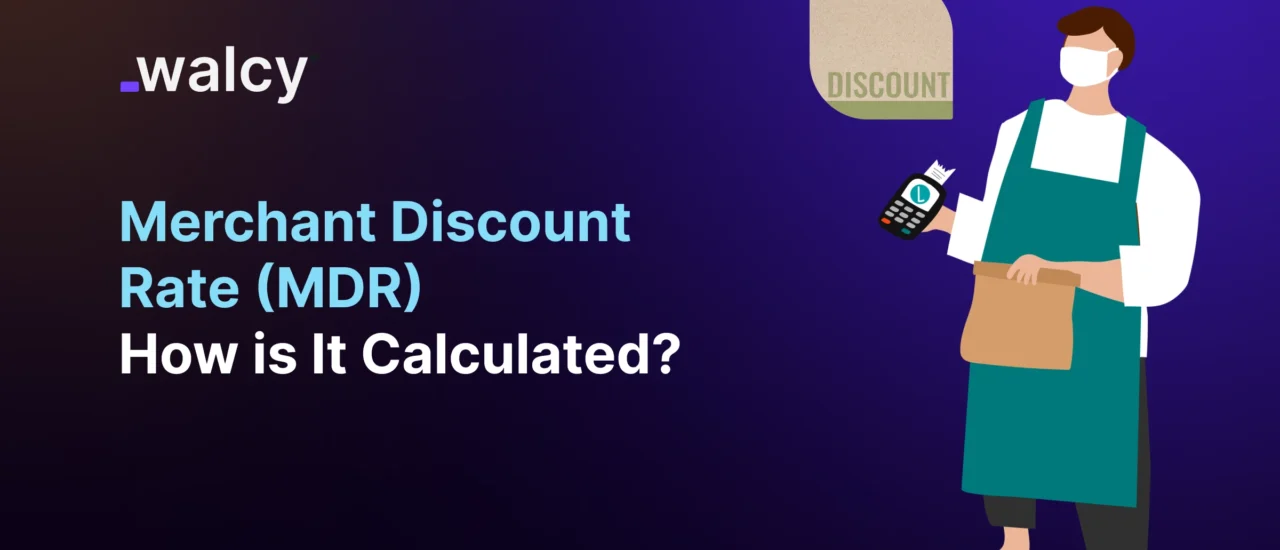As commerce becomes increasingly digital today, card payments help businesses big and small serve their customers. However, for each transaction, the merchant has to bear a certain fee, better known as the Merchant Discount Rate or MDR.
It thus becomes imperative to understand what MDR is, so one can balance managing the books of accounts with engaging the right payment processing partners. This blog will discuss the Merchant Discount Rate, including what it is, how it works, what influencing factors set its charges, and its impact on merchants.
What is the Merchant Discount Rate (MDR)?
The rate at which payment providers charge businesses and merchants for debit or credit card transactions is known as the Merchant Discount Rate (MDR). Due to the intricate network of financial institutions involved in processing card transactions, payment data frequently needs to be shared between many parties for transactions to be completed.
The MDR often called the Transaction Discount Rate (or TDR for short), is a cost that acquirers impose on merchants in exchange for the merchant account maintenance and use of payment processing services for debit or credit card transactions. Before starting to take card payments, merchants often sign up for the service and then reach an agreement with their acquirer on the MDR.
How Does the Merchant Discount Rate (MDR) Works?
Merchant Discount Rate is a sort of commission taken by a merchant every time a consumer makes any form of payment through credit/debit cards. It is usually a certain percentage of the transaction value and reimburses the participants involved in processing that transaction. Here’s how it works in a step-by-step manner:
Customer Makes a Payment:
The customer, to make any purchase of goods or services, initiates the transaction by providing details of his card either on the website or through a point-of-sale system in physical stores using his credit or debit card.
Merchant Receives Payment Request:
The merchant sends a request for payment to the acquiring bank, known as the acquirer. This turns the acquirer into the one that initiates the transaction and routes it through the right channels.
Issuer Authorization:
Information about the card is forwarded to the cardholder’s bank, which is also called an issuer so that verification can be made to check upon the card for validity and also to confirm whether the customer has sufficient funds or balance in his available credit to go ahead with the transaction. Then, the authorization or decline response will be issued by the issuer.
Processing the Transaction:
When the transaction is authorized, the details of the payment go across the respective payment network, be that Visa, Mastercard, or any other network, and finally to the acquiring bank. An acquirer facilitates the transaction between the cardholder’s bank issuer and the merchant.
MDR Deduction:
MDR stands for Merchant Discount Rate. The payment from the cardholder’s bank reaches the Merchant’s acquiring bank after the transaction has been authorized. However, the merchant receives only the amount after the deduction of the final sale and not the whole amount of the sale. In fact, the acquirer takes a small percentage, known as MDR for paying the charges of the concerned payment network, the issuer, and the payment processor.
Settlement:
The residue that is available after the deduction of the amount by MDR is credited to the merchant’s account. It is called settlement, and it may take a day or two depending upon the agreements between the merchant and the payment processor.
How to Determine a Merchant Discount Rate?
Setting an MDR is not one-size-fits-all but it is a factor of several variables. Here are the key determinants when setting MDR:
Type of the transaction:
The nature of the transaction pretty much determines the value of MDR. Credit card transactions usually have a higher MDR value than any debit card transaction.
This again is primarily because credit transactions carry far greater risks than normal ones, in terms of chargebacks and frauds. Therefore, merchants must be fully aware of these distinctions while considering payment processing costs.
Read about: International Payment Fraud: Ultimate Guide For Businesses.
Industry type:
The type of industry a merchant is in will have a big impact on their MDR. Industries that are higher risk travel, hospitality, or e-commerce industries the threat of fraudulent transactions and chargebacks.
Therefore, companies involved in such businesses may have to incorporate risks specified in their industries during negotiations with the payment processor in effort to attest their MDR.
Volume of Payment:
The more significant the number of transactions a merchant is handling, the better the grounds for negotiating lower MDR charges. Perhaps for this reason, the payment processor will give more competitive rates for companies that can process more significant transactions; this is a guarantee of constant revenue on the part of the processor.
A business, therefore, ought to study its transaction history and try to negotiate favorable terms on MDR based on its volume.
Means of Payment:
The means of payment also has an effect on MDR. For example, generally, MDR charges on debit cards are low as compared to credit cards because debit transactions are less risky for the processor.
A merchant should analyze the accepted modes of payment and their impact on overall MDR to make better, informed decisions concerning his approach to payment processing.
By understanding all these factors, merchants will have a better opportunity to estimate their MDR and seek ways to optimize the cost arising from payment processing while minimizing financial risk.
How is the Merchant Discount Rate Calculated?
The formula for MDR is quite straightforward:
MDR (%) = (Fees Paid to Payment Processors ÷ Total Transaction Value) × 100
For example, if a merchant is paying $2 as fees on a $100 transaction, the MDR will be:
MDR = 2/100 * 100 = 2%
The rate may be also a fixed amount, especially for debit card transactions below some thresholds.
Types of Merchant Discount Rates
There are several Merchant Discount Rate models a merchant can use, each with their merits and shortcomings. Some major varieties include:
Flat Rate MDR
A fixed percentage of the amount paid by the merchant in receiving the transaction money irrespective of the card type or the value of the transaction. This model is straightforward to understand; the simplicity and clarity of this model make it appealing for minor organizations or businesses with fewer transactions.
However, it cannot be considered efficient in terms of cost for high-volume businesses, since it would likely be paying out much more in fees compared to what would be observed under other models where the rates would be lower given the magnitude of the transaction or the type of card used.
Interchange Plus MDR
Under the interchange plus model, the merchant pays the actual interchange fee set by card networks, including either Visa or Mastercard, and also pays a markup fee charged by the payment processor. This method gives more transparency over the cost, as merchants can tell what amount of the fee is going to the card networks and how much is towards the payment processor.
However, this might require the merchant to have more basic knowledge about interchange fees, which can be complex and variable according to the card types and conditions of the transaction.
Tiered MDR
Under this system, different charges are levied from the merchant based on the different types of cards used by the customer, such as premium, corporate, or business cards, or based on the type of transactions, including in-store purchases or online buys. Merchants fall under different categories, with each category being allocated a particular rate.
The model allows for some flexibility; it can also be quite cumbersome to work with due to the multiple rates associated with each category. Merchants have to be in tune with the tiered system so they will not overpay on transactions that can fall into a low-category rate.
Factors Affecting Merchant Discount Rate (MDR) Charges
Some factors clearly can make a difference in the MDR charges that a merchant would finally pay. Here are key considerations:
Card Type:
The type of card used during transactions has a lot of importance in the determination of MDR. Premium or reward cards have a higher MDR owing to the benefits and incentivization that come along with cardholders, such as cashback or travel points.
These are subsidized by fees paid by merchants; hence, if a business accepts such kinds of cards, they should set themselves up for increased processing costs.
Size of transaction:
The size of the transaction can also have an impact on MDR. The percentage MDRs for larger transactions are smaller due to economies of scale payment processors can give reduced rates because the amount sold is larger.
Smaller transactions, in turn, could face higher MDRs because fixed processing costs remain the same irrespective of the amount transacted.
Payment Network Fees:
These interchange fees change with different payment networks, such as Visa and Mastercard. Thus, interchange directly determines the total MDR that will be charged to merchants.
Each of these fees can be further differentiated based on card type and how the transaction is conducted, whether online or in-store. The knowledge of network fee structures is crucial for merchants, as such fees can greatly impact their overall processing cost.
Risk Profile:
The fact that the risk profile of a merchant or industry could be different makes varied charges appropriate in MDRs. For example, high-risk industries like travel, gaming, or e-commerce will have higher MDRs due to a greater element of fraud and chargeback possibilities.
Similarly, merchants who have witnessed chargebacks or fraudulent activities earlier may have higher rates because the payment processors need to price their services appropriately to cover the perceived risk from such transactions.
Read more about: International Money Transfer Charges | How Much Does It Cost?
Impact of Merchant Discount Rate (MDR) on Merchants
This MDR rate can eat into the bottom line, especially for small businesses where even minuscule fees build up over time. High charges of MDR reduce profit margins; therefore, a small business should be aware of how effective it is to accept a card payment. Small businesses should take further steps towards their choices in payment processing regarding profitability, though it is for convenience.
Even a 0.1% difference in MDR would thus translate into quite substantial savings for large businesses dealing with high volumes of transactions over time. This segment of businesses typically can negotiate much better rates with any payment processor because of their volume, and their contracts with payment processors need to be reviewed periodically.
On the other hand, businesses have to balance the convenience and efficiency of card purchases against the cost of their acceptance in a manner that would provide customer satisfaction and profitability.
Conclusion
In brief, MDR plays a vital role in the payment processing trend, and its impact still lingers on small and large businesses. A merchant should understand types of MDR, the factors contributing to it, and its impact on the overall profitability to institute effective strategic steps in payment processing.
By carefully considering the MDR charges and studying different pricing models, a business can make better decisions on how it should optimize its financial performance. The ultimate balance between acceptance of card payments and management of its costs may come out with better customer satisfaction and sustained growth in today’s competitive marketplace.
FAQs
- What is MDR in banking?
MDR in banking abbreviated for Merchant Discount Rate, which is the commission charged by the bank to the merchant for card transaction processing.
- How is the MDR different from the interchange fee?
The interchange fee is arrived at by a card network and paid to a bank holding the cardholder’s account. MDR, on the other hand, incorporates interchange fees alongside other charges that go to the acquirer and payment processor.
- Can MDR charges vary depending on the means of payment?
Yes, MDR charges on debit cards are usually less than those on credit cards.
- How to reduce my MDR?
Merchants may lower their MDR through negotiation with payment processors, incremental growth in volumes of transactions, or shifting to a less complex MDR model.
- Is MDR charged only for credit and debit card payments?
Yes, it is usually the card-based transaction on which charges under MDR are charged; both credit and debit cards are included.
Do follow us on Facebook and LinkedIn, to stay connected with us.



